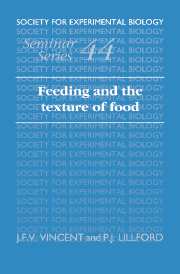Book contents
- Frontmatter
- Contents
- List of contributors
- Introduction
- Mechanical and fracture properties of cellular and fibrous materials
- Texture of plants and fruits
- Measuring meat texture and understanding its structural basis
- Food processing by mastication in cyprinid fish
- Quantitative aspects of the relationship between dentitions and diets
- The control of movements and forces during chewing
- The basic mechanics of mastication: man's adaptive success
- Integrating texture and physiology – techniques
- Brittle textures in processed foods
- The control and generation of texture in soft manufactured foods
- Texture and acceptability of human foods
- Index
Measuring meat texture and understanding its structural basis
Published online by Cambridge University Press: 14 January 2010
- Frontmatter
- Contents
- List of contributors
- Introduction
- Mechanical and fracture properties of cellular and fibrous materials
- Texture of plants and fruits
- Measuring meat texture and understanding its structural basis
- Food processing by mastication in cyprinid fish
- Quantitative aspects of the relationship between dentitions and diets
- The control of movements and forces during chewing
- The basic mechanics of mastication: man's adaptive success
- Integrating texture and physiology – techniques
- Brittle textures in processed foods
- The control and generation of texture in soft manufactured foods
- Texture and acceptability of human foods
- Index
Summary
The flesh of animals, and especially the muscle tissue, is a highly nutritious food. There are many carnivores and omnivores that have evolved to hunt or scavenge and eat the flesh from other animals; however in this chapter I shall concentrate on the human consumption of meat in a modern context, and particularly on our understanding of its textural qualities. It is a reasonable assumption that, in prehistoric times, obtaining a sufficient supply was the overriding priority. When there was enough to eat, the wholesomeness of the meat (i.e. freedom from disease, parasites and bacteriological spoilage) was most probably the first aspect of choice. The practice of cooking of meat may have conceivably come about as a way of reducing the risk of eating infected or rotting meat. In some areas of the world today, being able to obtain or afford meat is still a problem for many people. In Western society the supply and the wholesomeness of the supply of meat is largely taken for granted (although recent worries about Salmonella, Listeria and bovine spongiform encephalopathy show that wholesomeness is still an overriding concern) and the eating quality of meat – its taste, juiciness and texture – becomes a great consideration.
Food texture is an attribute that is determined principally in the mouths of consumers. When we eat meat, the process of chewing initially involves the breakdown or fracture of the material due to the loads and deformations imposed on it by the teeth. The ease or difficulty with which these fracture processes are achieved is sensed by physiological transduction mechanisms and forms the sensory perception of tenderness or toughness as described by a taste panel.
- Type
- Chapter
- Information
- Feeding and the Texture of Food , pp. 35 - 56Publisher: Cambridge University PressPrint publication year: 1991
- 12
- Cited by



